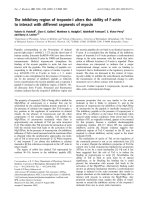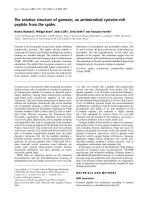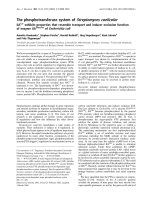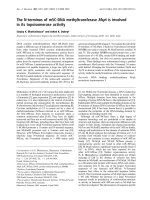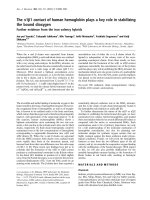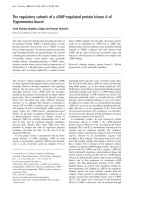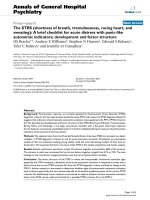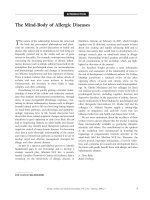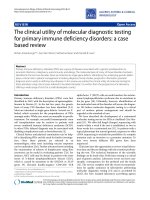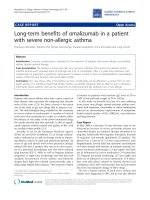Báo cáo y học: " The economic benefits of reducing physical inactivity: an Australian example" pptx
Bạn đang xem bản rút gọn của tài liệu. Xem và tải ngay bản đầy đủ của tài liệu tại đây (258.03 KB, 8 trang )
RESEARCH Open Access
The economic benefits of reducing physical
inactivity: an Australian example
Dominique A Cadilhac
1,2,3,4*
, Toby B Cumming
2
, Lauren Sheppard
3
, Dora C Pearce
4
, Rob Carter
3
and
Anne Magnus
3
Abstract
Background: Physical inactivity has major impacts on health and productivity. Our aim was to estimate the health
and economic benefits of reducing the prevalence of physical inactivity in the 2008 Australian adult population.
The economic benefits were estimated as ‘opportunity cost savings’, which represent resources utilized in the
treatment of preventable disease that are potentially available for re-direction to another purpose from fewer
incident cases of disease occurring in communities.
Methods: Simulation models were developed to show the effect of a 10% feasible, reduction target for physical
inactivity from current Austral ian levels (70%). Lifetime cohort health benefits were estimated as fewer incident
cases of inactivity-related diseases; deaths; and Disability Adjusted Life Years (DALYs) by age and sex. Opportunity
costs were estimated as health sector cost impacts, as well as paid and unpaid productio n gains and leisure
impacts from fewer disease events associated with reduced physical inactivity. Workforce production gains were
estimated by comparing surveyed participation and absenteeism rates of physically active and inactive adults, and
valued using the friction cost approach. The impact of an improvement in health status on unpaid household
production and leisure time were modeled from time use survey data, as applied to the exposed and non-exposed
population subgroups and valued by suitable proxy. Potential costs associated with interventions to increase
physical activity were not included. Multivariable uncertainty analyses and univariate sensitivity analyses were
undertaken to provide information on the strength of the conclusions.
Results: A 10% reduction in physical inactivity would result in 6,000 fewer incident cases of disease, 2,000 fewer
deaths, 25,000 fewer DALYs and provide gains in working days (114,000), days of home-based production (180,000)
while conferring a AUD96 million reduction in health sector costs. Lifetime potential opportunity cost savings in
workforce production (AUD12 million), home-based production (AUD71 million) and leisure-based production
(AUD79 million) was estimated (total AUD162 million 95% uncertainty interval AUD136 million, AUD196 million).
Conclusions: Opportunity cost savings and health benefits conservatively estimated from a reduction in
population-level physical inactivity may be substantial. The largest savings will benefit individuals in the form of
unpaid production and leisure gains, followed by the health sector, business and government.
Background
Physical activity, which is increasingly being engineered
out of our working and social lives, is important to
maintaining health. Physical activity enhances muscle
strength, a erobic capacity and psychological well-be ing,
while moderating health risk factors such as obesity,
high cholesterol and hypertension [1]. Physical activity
levels equivalent to 2. 5 hours per week of moderate-
intensity activity (i.e. an effort equivalent to brisk walk-
ing, or approximately 4000 kJ/week) are considered
important targets to achieve health benefits [2]. Evi-
dence suggests that walking for half an hour a day, five
daysaweek,mayincreaselifeexpectancyby1.5to3
years depending on the intensity [3]. The time lag
between increasing physical activity and observing
health benefits is relatively short [ 4,5]. However, many
people do not participate in regular physical activity.
The two main barriers appear to be time limitations and
* Correspondence:
1
Stroke and Ageing Research Centre, Southern Clinical School, Monash
University, Clayton 3168, Vic, Australia
Full list of author information is available at the end of the article
Cadilhac et al. International Journal of Behavioral Nutrition and Physical Activity 2011, 8:99
/>© 2011 Cadilhac et al; licensee BioMed Central Ltd. This is an Open Access article distributed under the terms of the Creative
Commons Attribution License ( which permits unrestricted use, distribution, and
reprodu ction in any medium, provided the original work is properly cited.
dissatisfaction, since many do not enjoy exercise [6]. In
Australia, there is evidence that 70% of adults are either
sedentary or have a low activity level [ 7]. Evidence from
three national health surveys conducted between 1995
and 2005 suggest that the proportions of Australians
reporting sedentary or low exercise levels have not
changed markedly over the last ten years [7,8].
A sedentary lifestyle has been associated with a great er
risk of all-cause mortality [9]. Inactivity is also associated
with increased risk of cardiovascular disease [10],
ischemic stroke [11], non-insu lin-dependent (type 2) dia-
betes [12], co lon cancer [13], osteo porosis [14], hip frac-
ture following falls [15] and depression [16]. Nearly 7% of
Australia’s health burden has been attributed to physical
inactivity, with the greatest contributors being ischemic
heart disease (51%), type 2 diabetes (20%) and stroke
(14%) [2]. Therefore, encouraging increased physical
activity levels is important. A range of interventions are
effective for reducing inactivity, including those that pro-
vide professional guidance and on-going support [17],
targeted information, behavioral and social interventions
(e.g. community based social support programs), and
environmental and policy interventions [18,19].
Few authors have quantified the economic costs of phy-
sical inactivity and the value of increasing participation in
physical activity to levels that produce health benefits. In
studies from Canada, Switzerland, the United Kingdom
(UK) and United States (US), annual direct healthcare
costs attributable to physi cal inactivity ranged from 1.5%
to 3% of total direct health costs [ 20]. Regular physical
activity can improve musculoskeletal and cardiovascular
health and enhance mental well being, which in a popula-
tion improves general health and productivity. Govern-
ments can benefit through future savings in avoidable
health care expenditure, increased income taxation and
fewer welfare payments. Businesses benefit from reduced
absenteeism and lower recruitment and training costs
associated with replacing staff, and individuals benefit
from more income and increased quality of life.
The aim of this study was to quantify the health and
economic benefits that could be achieved following a
feasible reduction (as opposed to a complete elimina-
tion) of physi cal inactivity in the Australian adult popu-
lation. This study was part of a larger study funded by
the Victorian health promotion foundation (VicHealth)
whereb y the benefits of feasible reductions in the preva-
lence of alcohol, physical inactivity, high body mass
index, tobacco smoking, inadequate consumption of
fruit and vegetables, and intimate partner violence were
estimated [21].
Methods
To estimate the health and economic benefits to society,
the impact of an absolute reduction in the prevalence of
physical inactivity levels for the 2008 Australian popula-
tion was measured as reduced incident cases of preven-
table physical inactivity-related diseases, deaths and
disability a djusted life years (DALYs). Relevant diseases
affected included cardiovascular disease, cancers, frac-
tures and depression.
The initial step was to agree on a feasible target reduc-
tion in the prevalence of physical inactivity. The feasible
reduction targets selected for physical inactivity in Aus-
traliawerebasedonexpertconsensus via discussions
with the study-specific Advisory Committee and consul-
tation with health promotion experts coupled with a
review of the broader intervention-based literature. The
evidence from the literature indicated that health benefits
should accrue when the prevalence of physical inactivity
is reduced by 5% to 10%. In the systematic review of
Kahn et al. [18], there were 5 studies that used commu-
nity-wide intervention campaigns and reported change in
the percentage of people being active. The median net
increase was 4.2%, with one study reporting an increase
of 9.4%. In 2000, the US set the objective of increasing
the percentage of people doing at least 30 minutes of
moderate physical activity regularly from 15% to 30%
over 10 years [22]. Individually targeted interventions
have yielded greater increases in activity, with differences
in the region of 20-30 per centage points between inter-
vention and control groups in the proportion of people
walking for at least 20 minutes per day at least 3 times
per week [23,24]. Stephenson et al [25] nominated 5%
and 10% point shifts in prevalence as part of their sensi-
tivity analyses of the benefits of increased physical activ-
ity in an Australian cost-of-illness study. Similarly,
Katzmarcyk et al aimed for a reduction of 10% in inactiv-
ity levels in Can ada [26]. Another option we considered
was to make a compariso n with another country u sing
the concept of an ‘Arcadian ideal’ [27]. However, this
approach was judged less robust since: a) we could not
identify a country that was demographically and cultu-
rally comparable to Australia and where the prevalence
of physical inactivity was lower; and b) the variations in
the definition o f ‘physical inactivity’ meant we could not
be certain that such a compariso n was valid. In Austral ia,
the recommended level of physical activity is defined as 3
sessions of at least 20 minutes vigorous exercise or 5 ses-
sions of at least 30 minutes moderate exercise per week
[2]. Thus a 10% reduction in physical inactivity was
selected as an ideal feasible target, and a progres siv e tar-
get of 5% were both modeled.
The comparator groups analyzed were the exposed
Australian population of inactive people (defined as
sedentary or low activity category that did not meet
recommended activity lev els), and the non-exposed
active population ( defined as moderate to high activity
that met or exceeded recommended activity levels).
Cadilhac et al. International Journal of Behavioral Nutrition and Physical Activity 2011, 8:99
/>Page 2 of 8
The net difference in mortality, incident morbidity and
consequent health sector costs and the impact on paid
and unpaid production and leisure between the current
prevalence of physical inactivi ty and the two target pre-
valence levels for the 2008 Australian adult population
was then estimated with population-based simulation
models developed in Excel (Microsoft Corporation,
2003). Cost data from other years were adjusted to 2008
by applying health price inflators [28]. A 3% discount
rate for lifetime benefits was applied [29], and varied in
sensitivity analyses using 0%, 5% and 7% (dat a not
reported but available from the authors).
Simulation models and data analyses
The Workforce Production Gains model developed by
Magnus et al [30] was adapted in the current study to
estimate the production gains/losses and taxation effects
in the Australian economy if a target reduction in physi-
cal inactivity prevalence were achieved. The model
includes simulation of a theoretical cohort of Australians
(ages 15-65 years) during their working years until retire-
ment age. In this model the working lifetime income
earned and taxation paid is calculated taking into account
known participation rates and absenteeism rates by age
and sex of the exposed and the non-exposed sub popula-
tions. The production gains or losses arise from changes
in income earned and taxation paid that result from the
reduction in deaths and incident cases of disease and dis-
ability, associated with the reduction in prevalence of
physical inactivity in the adult population. Two methodo-
logical techniques were used to value the production
gains or losses. The Friction Cost Approach (FCA)
assumes individuals who die or leave the work force due
to disability (for example, following a stroke) wi ll be
replaced after a specified period resulting in shorter term
product ion losses to society. As a sensitivity analysis, the
second technique adopted to value production gains or
losses was the Human Capital Approach (HCA) which
counts all future income up to age 65, as lost from an
individual who leaves the workforce due to death or dis-
ability. There remains debate in the economic literature
about which method is preferable [31,32] since they give
such divergent results. For the purposes of the current
study, the FCA had a stronger logical connection to the
actual likely cost impact on industry and was considered
toprovideamorerealisticeconomicestimate.Three
months was used as the friction period [31,33] and was
varied to 6 months in sensitivity analyses.
The Household Production and Leisure Time model
was developed to estimate the net difference in the eco-
nomic value of hours of lost leisure and household pro-
duction associated with diseases attributable to physical
inactivity. The model incorporated surveyed time alloca-
tions of both working and non-working adults by gender
and age. Household production was defined as the hours
spent performing non-paid h ousehold duties such as
cooking, shopping, cleaning, child care and maintenance.
Thesewerevaluedat‘replacement cost’ ,wherebythe
duties unable to be performed due to illness were pur-
chased commercially. Unit prices for household produc-
tion were based on the average 2008 wage rates for
domestic services and child care. Leisure time comprised
social and community interaction, together with recrea-
tion and leisure activities only. Leisure time was valued
using t he ‘opportunity cost method’ , applying one third
of the average 2008 weekly earnings for men and
women [34]. The Nat ional Health Survey (NHS) pro-
vided self-reported days out of role for the exposed
(inactive) and non-exposed (active) Australian popula-
tions. It was assumed on these days that the household
duties and leisure time normally performed, would not
be performed, involving an economic loss of leisure
time and the need to replace the household activities
commercially. Following the reduction in the prevalence
of physically inactive persons in the Australian popul a-
tion there was a change in the number of days of house-
hold and leisure activities lost to ill health. The net
difference in the value of the days of household produc-
tion and leisure time between the current prevalence
and targeted physically inactive and active prevalence
was counted as the economic gain.
Health sector cost estimation
To estimate changes in health sector costs, the attributable
portion of total health sector costs to diseases associated
with physical inactivity were estimated using Population
Attributable Fractions (PAF) [2]. A PAF is the proportion
by which the incidence of a disease in a population could
be reduced if the risk factor or exposure was to reach a
‘theoretical minimum’ - the lowest possible level of risk in
a population [2]. Calculation of a PAF is informed by epi-
demiologic studies where relative risk estimates for disease
have been reliably determined for people exposed and not
exposed to single risk factors. In the current study, PAFs
for diseases attributable to physical inactivity were taken
for males and females by age group from the 2003 Austra-
lian Burden of Disease study [2]. The modeling of lifetime
health expenditure costs from these data was not
attempted. Rather, a conservative approach was taken,
where only the annual health sector costs of treating inci-
dent cases of disease attributable to physical inactivity
were assumed to approximate the health sector cost sav-
ings of a reduction in the prevalence of physical inactivity
for our reference (2008) population.
Data sources
The most up-to-date Australian data sources were used.
The current estimates for the prevalence of physical
Cadilhac et al. International Journal of Behavioral Nutrition and Physical Activity 2011, 8:99
/>Page 3 of 8
inactivity (overall 70%) by age and gender were obtained
from the 2004/5 NHS [7] confidentialized dataset with
the approval of the Australian Statistician, Australian
Bureau of Statistics (ABS) [7,35]. Respondents self
reported how much exercise they had undertaken in the
two weeks prior to the survey and categorized their
exercise according to intensity.
Demographic data, employment status, and health-
related actions of physically inactive and ac tive adults
were also obtained from the 2004/5 NHS dataset (Table
1). PAFs, health status estimates including incident
cases of physical inactivity-related disease, deaths and
DALYs were obtained using the 2003 Australian Burden
of Disease data files [2] that were made available for this
study. The 2000-01 Disease Costs and Impact Study
Excel files [36], which adopted the Burden of Disease
classification system, were used to estimate the change
in health sector costs from diseases associated with phy-
sical inactivity. Household production and leisure time
were derived from the 2006 ABS Time Use Survey as
described earlier [37]. Current average wages were
sourced from the ABS and published government pay
scale summaries [38,39].
Uncertainty analyses
Multivariable probabilistic uncertainty analyses were
undertaken using @RISK software version 4.5 for Excel
(Palisade Corporation, 2005). Input variables were mod-
eled as known distributions rather than single values
where uncertainty existed (e.g. each surveyed parameter
and life-years remaining). Uncertainty in wages, partici-
pation rates and absenteeism were captured in the
reported survey standard errors [7,38,39]. Monte Carlo
sampling with minimum 4,000 simulations were used to
estimate a mean and 95% uncertainty interval for the
outcome parameters.
Comprehensive details on our methods are provided
in the full technical r eport [21] available at http://www.
vichealth.vic.gov. au/~/media/Re sourceCentre/Publi ca-
tionsandResources/Knowledge/Research%20Report_FI-
NAL_July09.ashx and are also reported in the
publication on tobacco smoking and the combined ana-
lysis of the six risk factors [40,41].
Results
Table 1 presents the demographic data and days of
reduced activity for physically active and physically inac-
tive persons by age, gender and workforce status. Physi-
cally inactive females participated less in t he workforce
than physically active females. Among the physically
inactive females in the workforce, more took days off
work compared with physically active females. In addi-
tion, the physically inactive females not in the workforce
had more day s of reduced activity when compared to
Table 1 Demographics and days of reduced activity due to ill health by age, gender and work force status for the
2008 adult Australian population
Male Female
Physically inactive Physically active Physically inactive Physically active
Age summary
Age 15-64 y
N (95% CI)
4,332,994
(4,229,842 - 4,436,146)
2,322,617
(2,220,059 - 2,425,175)
4,798,508
(4,704,081 - 4,892,935)
1,864,120
(1,769,404 - 1,958,836)
Age 65+ y
N (95% CI)
775,817
(746,962 - 804,671)
342,985
(313,395 - 372,575)
1,059,103
(1,028,507 - 1,089,698)
260,571
(230,005 - 291,136)
Mean age (15+ years) (95% CI) 44.9
(44.6 - 45.3)
40.6
(40.1 - 41.2)
45.3
(45.0 - 45.6)
42.5
(41.6 - 43.3)
In Labour Force (15+ years)*
% (95% CI) 75%
(73% - 76%)
75%
(73% - 77%)
57%
(56% - 58%)
65%
(63% - 67%)
Mean days off work (95% CI) 0.32
(0.26 - 0.38)
0.26
(0.18 - 0.34)
0.31
(0.26 - 0.35)
0.23
(0.16 - 0.29)
Not in Labour Force
% (95% CI) 26%
(24% - 27%)
25%
(23% - 27%)
43%
(42% - 44%)
35%
(33% - 37%)
Mean days of reduced activity: 15-64 y (95% CI) 1.93
(1.60 - 2.26)
0.88
(0.54 - 1.21)
1.45
(1.26 - 1.65)
0.84
(0.62 - 1.05)
Aged 65+ years
% (95% CI) 15.2%
(14.6% - 15.8%)
12.9%
(11.8% - 14.0%)
18.1%
(17.5% - 18.7%)
12.3%
(10.8% - 13.8%)
Mean days of reduced activity (95% CI) 1.56
(1.25 - 1.87)
0.43
(0.22 - 0.65)
1.75
(1.53 - 1.96)
0.73
(0.50 - 0.96)
Source: National Health Survey 2004-05 (ABS, 2006); CI: Confidence Interval; N: Number. Mean days measured over a two week period. *includes unemployed
seeking work and 65+ years
Cadilhac et al. International Journal of Behavioral Nutrition and Physical Activity 2011, 8:99
/>Page 4 of 8
physically active females not in the workforce. Physically
inactive males, who were not in the workforce, had
more days of reduced activity compared to physically
active males.
Iftheprevalenceofphysicalinactivityintheadult
Australian population was reduced by 10%, the esti-
mated 45,000 annual new cases of physical inactivity-
related disease could be reduced by 6,000 (13%); the
13,000 annual deaths attributed to physical inactivity
could be reduced by 2,000 deaths (15%); and the
174,000 DALYs lost from physical activity could be
reduced by about 25,000 (14%) (Table 2). Half of these
benefits would be achieved if the progressive target (5%
reduction) in the prevalence of physical inactivity was
met.
The estimated benefits from reduced physical inactiv-
ity resulted in potential opportunity cost savings of
AUD96 million to the h ealth sector (0.19% of total
annual health sector costs and 14% of attributable
annual health sector costs to this risk factor), AUD12
million i n workforce production (FCA), AUD 71 million
in home based production and AUD79 million in leisure
based production (Table 3). This represents approxi-
mately 14% of the total production cost losses attributa-
ble to this risk factor (AUD1,135 million). The largest
component of these total potential opportunity cost sav-
ings would occur in household production and leisure,
followed by the health sector and workforce (Figure 1).
AUD in 2008 can be converted to US dollars, using the
purchasing power parity of AUD1.48 [42].
Discussion
The primary finding of this study is that a feasible
reduction in prevalence of physical inactivity can lead to
total potential opportunity cost savings of AUD258 mil-
lion, with 37% of the savings arising in the health sector.
The largest savings would benefit individuals, followed
by the health sector, business and government. These
savings would be much larger if all physical inactivity
was eliminated (AUD672 million in health sector,
AUD1,135 million [FCA] in production and leisure), but
our aim was to estimate savings that were realistic and
relevant to the setting of future public health campaigns
and disease prevention strategies.
A novel and important aspect of the present study was
the inclusion of benefits for workforce, household pro-
duction and leisure time associated with reduced physi-
cal inactivity. The choice of appropriate methods for
quantifying and v aluing household production and lei-
sure time continue to be debated [43]. Nevertheless,
capturing household and leisure activities is increasingl y
regarded by health promotion agencies as essential to
appropriate population-level eco nomic modeling.
Indeed, this element was identified as the largest com-
ponent of the total opportunity cost savings to be made
through increased physical activity. This occurs because
Table 2 Health status and production effects from reducing the prevalence of physical inactivity
Benefit Feasible reduction target
a
95% Confidence Interval
Mean (’000s) Lower Limit (’000s) Upper Limit (’000s)
DALYs 25 n/a n/a
Incidence of disease 6 n/a n/a
Mortality 2 n/a n/a
Lifetime
Leisure (days) 316 300 331
Absenteeism (days) 114 n/a n/a
Days out of home based production role (days) 180 155 206
Early retirement (persons) 0.02 n/a n/a
Progressive target reduction
DALYs 12 n/a n/a
Incidence of disease 3 n/a n/a
Mortality 1 n/a n/a
Lifetime
Leisure (days) 158 150 166
Absenteeism (days) 57 n/a n/a
Days out of home based production role (days) 90 77 103
Early retirement (persons) 0.01 n/a n/a
a
10% net reduction in prevalence. Disability Adjusted Life Years (DALYs), incidence of disease and mortality calculated for all age groups. Leisure and home
based production calculated for persons aged 15+ years. Absenteeism and early retirem ent calculated for persons aged 15-64 years. All estimates uncorrected for
joint effects.
Cadilhac et al. International Journal of Behavioral Nutrition and Physical Activity 2011, 8:99
/>Page 5 of 8
the avoidable diseases associated with physical inactivity
are largely diseases occurring in older age groups. Older
individuals no longer in the workforce have potentially
the most to gain from increasing their levels of physical
activity, including quality of life. This is particularly rele-
vant in ageing populations (most of the developed
nat ions) where rises in future health sector costs are dri-
ven by the increased demand of an ageing population. In
addition, inclusion of these estimates is also important to
not underestimate the health and economic impacts of
incre asing physical activity in a community since there is
a gender bias to workforce participation and obvious dif-
ferences among females who are and are not in the work-
force, and who are physically active and inactive.
It is difficult to c ompare these estimates of potential
savings with earlier literatur e. The only previous Austra-
lian study to identify health sector costs associated with
physical inactivity estimated them at AUD377 million
[25]. The largest costs arose from preventing c oronary
heart disease (AUD161 million) and stroke (AUD101
million). In contrast, the current study was used to esti-
mated the annual health sector cost attributable to inci-
dent cases of physical inactivity at AUD672 million
(representing 1.3% of total annual health sector costs).
While the results are not directly comparable given fun-
damental methodological di fferences, both studies pro-
vide a valuable contribution to the literature regarding
the potential economic benefits of reducing physical
inactivity in Australia.
Other strengths of this work were the conservative
approach taken and the use of best available data. It was
assumedthatonlyincident cases of disease attributable
to physical inactivity f or the 2008 population would b e
reduced. Thus, future r eductions in disease risk among
those already ill (e.g. benefits gained from reducing inac-
tivity in people with existing cardiovascular disease)
were not incorporated in these analyses. Furthermore,
the impact on health sector costs for reduced mortality
is not easily modeled, since death-related costs occur
during a lifetime, rather than at the point of death. The
more conservative FCA estimates of workforce produc-
tion gains over the HCA were preferred by the investi-
gators of this present study, and represented less than
10% of the HCA estimates.
The reliance on self-reported cross-sectional data is a
limitation, since such data are less reliable than objective
measurement data, because people can exaggerate, fail
to remember, or misunderstand questions. The direction
of reporting bias is not always clear. In addition, other
Table 3 Economic outcomes from reducing the
prevalence of physical inactivity
Economic outcomes Feasible reduction target
a
95% Confidence Interval
Mean
(AUD
million)
Lower Limit
(AUD
million)
Upper Limit
(AUD
million)
Health sector costs 96 n/a n/a
Production Costs FCA 12 7 18
Recruitment and training
costs
5 n/a n/a
Taxation effects FCA
b
214
Leisure based production 79 60 103
Home based production 71 61 82
Total production FCA
c
162 136 192
Sensitivity analysis
Production Costs HCA 138 114 161
Taxation effects HCA
b
12 10 15
Total production HCA
c
288 253 326
Progressive target reduction
Health sector costs 48 n/a n/a
Production Costs FCA 6 3 9
Recruitment and training
costs
2 n/a n/a
Taxation effects FCA
b
1 0.26 2
Leisure based production 40 30 51
Home based production 36 30 41
Total production FCA
c
81 68 96
Sensitivity analysis
Production Costs HCA 69 58 81
Taxation effects HCA
b
658
Total production HCA
c
145 127 164
a
These are not estimates of immediately realizable cash savings
b
Taxation is
treated as a transfer payment and should not be added to production effects.
c
Total production is the sum of workforce production costs, household- and
leisure-based production. All estimates uncorrected for joint effects of the
presence of multiple risk factors in individuals. HCA: Human Capital Approach;
FCA Friction Cost Approach (preferred conservative estimate). Health sector,
leisure and home based production based on persons 15+ years. Production,
recruitment and training and taxation effects based on persons 15-64 years.
Figure 1 Proportion of opportunity cost savings from
reductions in physical inactivity by economic category. FCA:
Friction cost approach
Cadilhac et al. International Journal of Behavioral Nutrition and Physical Activity 2011, 8:99
/>Page 6 of 8
concurrent risk factors and socioeconomic status, not
controlled for in this analysis, could be a source of over-
estimation. It is also possible that people increase their
level of activity following the onset of an illness (e.g. dia-
betes, cardiovascular disease). Assuming causality in the
absence of r igorous longitudinal data means that the
results must be regarded as broadly indicative of what
might be achieved. A further limitation is that forecasted
gains will occu r over time. A quantitative assessment of
when opportunity cost savings and health status benefits
wouldbeachievedwasnotundertaken.Thisapproach
is rare because of the subsequent additional levels of
uncertainty, making estimates less reliable. However,
thereissomeevidencethatthetimelagbetween
increased physical activity and observe d benef its is rela-
tively short. Blair demonstrated that increasing activity
reduced all cause mortality within two years, which was
half the time required to observe benefits from smoking
cessation [4].
The selection of targets for risk factor prevalence
reduction is an important policy decision. It is possible
that a 10% reduction in physical inactivity prevalence is
an overly ambitious goal in the current Australian cli-
mate of increasing levels of obesity, with modern tech-
nology eliminating the need for many physical pursuits.
However, this b old target could be justified as feasible
given the high prevalence of inactivity.
Lastly, opportunity cost savings need to be carefully
interpreted. These savings will only be achieved by the
adoption of effective interventions that will invariably have
implementation and time costs attached to them. Includ-
ing intervention costs and effects was beyond the scope of
this study and it was assumed that acceptable effective
interventions exist to achieve the target reductions in phy-
sical inactivity. Opportunity cost savings are not estimates
of immediately realizable financial savings; they are esti-
mates of resources consumed in current practice t hat
could be made available for other purposes, such as invest-
ing in public health programs. Future, well-designed epi-
demiological and clinical research studies are needed to
provide better evidence to underpin d ecision analytic
modeling for health promotion, and for prioritizing speci-
fic interventions to achieve reductions in inactivity.
Investment in disease prevention and health promo-
tion in Australia is dwarfed by avoidable spending on
disease treatment. The findings of this project contri-
bute important new knowledge about the major impact
of physical inactivity on the productivity of individuals
in both the paid and unpaid sectors, as well as health
sector expenditure. The findings from this study rein-
force the argument that greater investment in risk factor
reduction strategies is required and economically justi-
fied, particularly in ageing populations.
Acknowledgements and funding
Funding for this study was provided by VicHealth following a competitive
tender process. We thank the Advisory committee members, relevant health
experts for this topic area and the VicHealth staff, including the Advisory
Committee Chair: Todd Harper. We also acknowledge Prof Theo Vos from
the University of Queensland for providing advice on disease risk factors and
data analysis methods.
Author details
1
Stroke and Ageing Research Centre, Southern Clinical School, Monash
University, Clayton 3168, Vic, Australia.
2
National Stroke Research Institute,
Heidelberg Heights 3081, Vic, Australia.
3
Deakin Health Economics, Deakin
University, Burwood Australia.
4
The University of Melbourne 3010, Australia.
Authors’ contributions
AM, DC and RC conceptualized the project. AM, DC, TC and LS conducted
literature reviews. AM and DC developed the economic models. DP
performed the data analyses. DC and TC wrote the initial draft of the paper.
All authors reviewed and contributed to drafts of the paper. All authors have
read and approved the final manuscript.
Authors’ Information
DC: Head Translational Public Health Unit, Stroke and Ageing Research
Centre, Monash University, Victoria. Head: Public Health. National Stroke
Research Institute, Heidelberg Heights, Victoria, Australia. Honorary Research
Fellow: Department of Medicine, The University of Melbourne, Australia and
Deakin Health Economics, Strategic Research Centre Population Health,
Faculty of Health, Deakin University, Burwood Deakin University and The
University of Melbourne, Parkville, 3010.
TC: Post-doctoral Research Fellow. National Stroke Research Institute,
Heidelberg 3084, Victoria, Australia
LS: Research Fellow. Deakin Health Economics, Strategic Research Centre
Population Health, Faculty of Health, Deakin University, Burwood, 3125,
Victoria, Australia
DP: Research Fellow, Melbourne School of Population Health, The University
of Melbourne, 3010, Parkville, Victoria, Australia.
RC: Founding Chair, Deakin Health Economics, Strategic Research Centre
Population Health, Faculty of Health, Deakin University, Burwood, 3125,
Victoria, Australia
AM: Senior Research Fellow, Deakin Health Economics, Strategic Research
Centre Population Health, Faculty of Health, Deakin University, Burwood,
3125, Victoria, Australia
Competing interests
The authors declare that they have no competing interests.
Received: 24 December 2010 Accepted: 24 September 2011
Published: 24 September 2011
References
1. Taylor AH, Cable NT, Faulkner G, Hillsdon M, Narici M, Van Der Bij AK:
Physical activity and older adults: a review of health benefits and the
effectiveness of interventions. Journal of Sports Sciences 2004,
22(8):703-725.
2. Begg S, Vos T, Barker B, Stevenson C, Stanley L, Lopez AD: The burden of
disease and injury in Australia 2003. In Volume PHE 82 Edited by: AIHW C
2007.
3. Franco OH, de Laet C, Peeters A, Jonker J, Mackenbach J, Nusselder W:
Effects of physical activity on life expectancy with cardiovascular
disease. Arch Intern Med 2005, 165(20):2355-2360.
4. Blair SN, Kohl HW, Barlow CE, Paffenbarger RS Jr, Gibbons LW, Macera CA:
Changes in physical fitness and all-cause mortality. A prospective study
of healthy and unhealthy men.[see comment]. JAMA 1995,
273(14):1093-1098.
5. Paffenbarger RS Jr, Hyde RT, Wing AL, Lee IM, Jung DL, Kampert JB: The
association of changes in physical-activity level and other lifestyle
characteristics with mortality among men.[see comment]. New England
Journal of Medicine 1993, 328(8):538-545.
6. Meltzer DO, Jena AB: The economics of intense exercise. J Health Econ
2010, 29(3):347-352.
Cadilhac et al. International Journal of Behavioral Nutrition and Physical Activity 2011, 8:99
/>Page 7 of 8
7. Australian Bureau of Statistics: National Health Survey 2004-05. In Volume
Cat No 4364.0 Edited by: Australian Bureau of Statistics. Canberra 2006.
8. Australian Bureau of Statistics: National Health Survey 1995: Summary of
Results Australia. In Volume Cat No 4364.0 Edited by: Australian Bureau of
Statistics. Canberra 1997, 75.
9. Blair SN, Kohl HW, Paffenbarger RS Jr, Clark DG, Cooper KH, Gibbons LW:
Physical fitness and all-cause mortality. A prospective study of healthy
men and women. JAMA 1989, 262(17):2395-2401.
10. Wannamethee SG, Shaper AG: Physical activity in the prevention of
cardiovascular disease: an epidemiological perspective. Sports Medicine
2001, 31(2):101-114.
11. Gorelick PB, Sacco RL, Smith DB, Alberts M, Mustone-Alexander L, Rader D,
Ross JL, Raps E, Ozer MN, Brass LM, et al: Prevention of a first stroke: a
review of guidelines and a multidisciplinary consensus statement from
the National Stroke Association. JAMA 1999, 281(12):1112-1120.
12. Helmrich SP, Ragland DR, Leung RW, Paffenbarger RS Jr: Physical activity
and reduced occurrence of non-insulin-dependent diabetes mellitus.
New England Journal of Medicine 1991, 325(3):147-152.
13. Giovannucci E, Ascherio A, Rimm EB, Colditz GA, Stampfer MJ, Willett WC:
Physical activity, obesity, and risk for colon cancer and adenoma in
men. Annals of Internal Medicine 1995, 122(5):327-334.
14. Kohrt WM, Snead DB, Slatopolsky E, Birge SJ Jr: Additive effects of weight-
bearing exercise and estrogen on bone mineral density in older women.
Journal of Bone & Mineral Research 1995, 10(9):1303-1311.
15. Jaglal SB, Kreiger N, Darlington G: Past and recent physical activity and
risk of hip fracture. American Journal of Epidemiology 1993, 138(2):107-118.
16. Camacho TC, Roberts RE, Lazarus NB, Kaplan GA, Cohen RD: Physical
activity and depression: evidence from the Alameda County Study.
American Journal of Epidemiology 1991, 134(2):220-231.
17. Foster C, Hillsdon M, Thorogood M: Interventions for promoting physical
activity. Cochrane Database of Systematic Reviews 2005, , 1: CD003180.
18. Kahn EB, Ramsey LT, Brownson RC, Heath GW, Howze EH, Powell KE,
Stone EJ, Rajab MW, Corso P: The effectiveness of interventions to
increase physical activity. A systematic review. American Journal of
Preventive Medicine 2002, 22(4 Suppl):73-107.
19. Graves N, Barnett AG, Halton KA, Veerman JL, Winkler E, Owen N,
Reeves MM, Marshall A, Eakin E: Cost-effectiveness of a telephone-
delivered intervention for physical activity and diet. PLoS One 2009, 4(9):
e7135.
20. Oldridge NB: Economic burden of physical inactivity: healthcare costs
associated with cardiovascular disease. European Journal of Cardiovascular
Prevention & Rehabilitation 2008, 15(2):130-139.
21. Cadilhac D, Cumming T, Sheppard L, Pearce D, Carter R: The economic
benefits of reducing disease risk factors. Melbourne: Deakin Health
Economics Group, Deakin University and National Stroke Research Institute;
2009.
22. United States Department of Health and Human Services: Healthy People
2010: Conference edition Washington, DC: Government Printing Office; 2000.
23. Dubbert PM, Cooper KM, Kirchner KA, Meydrech EF, Bilbrew D: Effects of
nurse counseling on walking for exercise in elderly primary care
patients. J Gerontol A Biol Sci Med Sci 2002, 57(11):M733-740.
24. Lombard DN, Lombard TN, Winett RA: Walking to meet health guidelines:
the effect of prompting frequency and prompt structure. Health Psychol
1995, 14(2):164-170.
25. Stephenson J, Bauman A, Armstrong T, Smith B, Bellew B: The costs of
illness attributable to physical inactivity in Australia: A preliminary study.
Edited by: Department of Health and Aged Care & Australian Sports
Commission 2000.
26. Katzmarzyk PT, Gledhill N, Shephard RJ: The economic burden of physical
inactivity in Canada.[see comment]. CMAJ Canadian Medical Association
Journal 2000, 163(11):1435-1440.
27. Armstrong B: Morbidity and mortality in Australia: how much is
preventable? In Text book of preventive medicine. Edited by: McNeil JJ, King
R, Jennings G, Powles J. Melbourne: Edwin Arnold; 1990:340.
28. AIHW: Public health expenditure in Australia 2006-07. In Volume AIHW
Cat no HWE 41 Edited by: Australian Institute of Health and Welfare.
Canberra 2008.
29. Gold MR, Siegel JE, Russell LB, Weinstein MC: Cost-effectiveness in health and
medicine New York: Oxford University Press; 1996.
30. Magnus A, Mihalopoulos C, Carter R: Evaluation of preventive health
interventions: Impact on production gains. Melbourne: Deakin Health
Economics Unit; 2008.
31. Koopmanschap MA, Rutten FF: A practical guide for calculating indirect
costs of disease. Pharmacoeconomics 1996, 10(5):460-466.
32. Liljas B: How to calculate indirect costs in economic evaluations.
Pharmacoeconomics 1998, 13(1):1-7.
33. Koopmanschap MA, Rutten FF, Van Ineveld BM, van Roijen L: The friction
cost method for measuring indirect costs of disease. Journal of Health
Economics 1995, 14:171-189.
34. Shaw WD, Feather P: Possibilities for Including the Opportunity Cost of
Time in Recreation Demand Systems. Land Economics 1999, 75(4):592-602.
35. Australian Bureau of Statistics: National Health Survey - Confidentialised
Unit Record Files.Edited by: Australian Bureau of Statistics. Canberra 2005.
36. AIHW: Health system expenditure on disease and injury in Australia,
2000-01. In Volume AIHW cat. no. HWE 26 Edited by: Australian Institute of
Health and Welfare. Canberra 2004.
37. Australian Bureau of Statistics: How Australians Use their Time, 2006.
In
Volume Cat no 4153.0 Edited by: Australian Bureau of Statistics. Canberra
2008.
38. Australian Bureau of Statistics: Labour Force, Australia, May 2007. In
Volume Cat no 6202.0 Edited by: Australian Bureau of Statistics. Canberra
2007.
39. Australian Bureau of Statistics: Average Weekly Earnings, May 2008. In
Volume Cat no 6302.0 Edited by: Australian Bureau of Statistics. Canberra
2008.
40. Magnus A, Cadilhac D, Sheppard L, Cumming T, Pearce D, Carter R:
Economic Benefits of Achieving Realistic Smoking Cessation Targets in
Australia. Am J Public Health 2011, 101(2):321-327.
41. Cadilhac DA, Magnus A, Sheppard L, Cumming TB, Pearce D, Carter R: The
societal benefits of reducing six behavioural risk factors: an economic
modelling study from Australia. BMC Public Health 2011, 11:483.
42. Purchasing Power Parities (PPP). [ />en_2649_34357_1_1_1_1_1,00.html].
43. Drummond MF, McGuire A: Economic Evaluation in Health Care: Merging
Theory with Practice Oxford: Oxford University Press; 2001.
doi:10.1186/1479-5868-8-99
Cite this article as: Cadilhac et al.: The economic benefits of reducing
physical inactivity: an Australian example. International Journal of
Behavioral Nutrition and Physical Activity 2011 8:99.
Submit your next manuscript to BioMed Central
and take full advantage of:
• Convenient online submission
• Thorough peer review
• No space constraints or color figure charges
• Immediate publication on acceptance
• Inclusion in PubMed, CAS, Scopus and Google Scholar
• Research which is freely available for redistribution
Submit your manuscript at
www.biomedcentral.com/submit
Cadilhac et al. International Journal of Behavioral Nutrition and Physical Activity 2011, 8:99
/>Page 8 of 8
